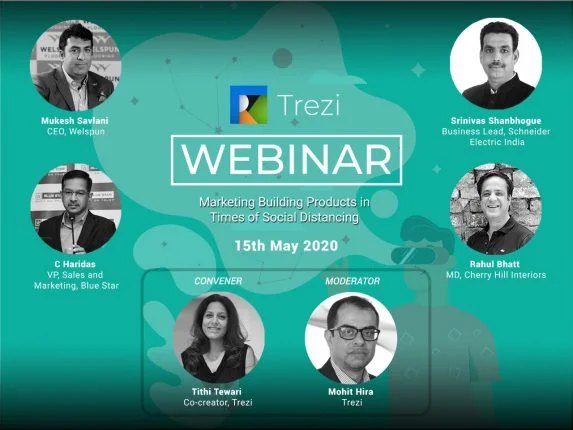The AEC industry is facing unprecedented challenges as a result of the Coronavirus pandemic. As we witness a rapid shift towards remote working, the adoption of new technology to facilitate design communication and collaboration is becoming even more critical.
A spirited and ultra-informative conversation on business and marketing strategies took place amongst business leaders of the AEC industry on May 15, 2020, as they ideated together on marketing strategies for building products in post-pandemic times in a free-flowing webinar.
Mukesh Savlani (CEO, Welspun), C Haridas (VP, Sales & Marketing, Blue Star), Srinivas Shanbhogue (Business Lead, Schneider Electric India) and Rahul Bhatt (MD, Cherry Hill Interiors) got together with Tithi Tewari and Mohit Hira of Trezi, to discuss the long-term impact of the pandemic on the AEC industry and the various business strategies their companies were adopting for the post-COVID-19 world.
There were many useful insights and several of these learnings were triggered by questions that the highly engaged audience asked our panelists:
Some of these are reproduced here:
- Hospitality, particularly Hotels & Restaurants, have been affected very badly. Are you foreseeing any specific changes in the layout considering the need to practise social distancing going forward?
Answer: Quite a few design typologies will be directly affected due to the pandemic. These effects will be seen in (and not limited to) new design parameters, standards and styles for (a) health & safety, (b) MEP/HVAC services and servicing and (c) overall sizing and space distribution between public and private spaces.
- A segment that has gone unrecognised by manufacturers is the academic segment. With ‘blended’ education being the new norm, this is the right time for manufacturers of building products to engage with Architecture Colleges. For example, a design studio project could be shared with, say Bluestar who could then engage with students in real time to exhibit air conditioning options or lighting and controls.
Answer: One way to blend education is to partner with industry to teach students hands-on design-thinking in specific product categories. Another way could be to offer ‘brownfield’ design projects to students where they are taught repurposing spaces from one use to another. This will teach adaptability, sustainability and green-design.
- Replacing physical samples with VR will take some time since physical samples offer more clarity than VR. Maybe, in the future, technology can overcome these limitations?
Answer: VR as a technology is still evolving and we will overcome these limitations in the near future. VR is already helping by optimising and saving costs and expenditure in physical samples.
- VR is a great advantage from a sustainability point of view. How can we leverage sales by using technologies such as VR?
Answer: VR and other collaborative technologies are high on the sustainability scale since, apart from savings in direct sampling costs, they also have a lower carbon footprint due to reduced travel, less wastage of resources, time and effort in decision making.
- How does Trezi help in marketing the products of different manufacturers?
Answer: Trezi has its own proprietary method for manufacturers to create and list their product catalogs directly in VR. These digital twins are full scale, have meta-data and can be published to prospective architects and specifiers to offer a full-scale immersive product experience.
- How do you think customers will be more involved in product development ?
Answer: Customers can be more involved in product development through the use of immersive technologies. These technologies give customers a virtual view of products, including variations, meta-data, all without having physical products shipped to them. Manufacturers too, can engage simultaneously with multiple customers/prospects/specifiers remotely through collaborative technologies to get collective product feedback faster.
- As a designer, will I have a new palette to select from, for new projects coming up?
Answer: Yes, Trezi’s online product library gives you access to different materials, products and finishes to select from for new projects. Manufacturers can add to their own virtual storefronts within Trezi and offer greater choices to designers and customers.
Missed the webinar?, Watch it here!
Stay tuned for more updates from Trezi!
To experience a free 14-day trial using your own SteamVR-compatible Virtual Reality kit, please sign up here.
Or contact us to organize a demo at your office – our sales representative will set up an appointment at your convenience.











